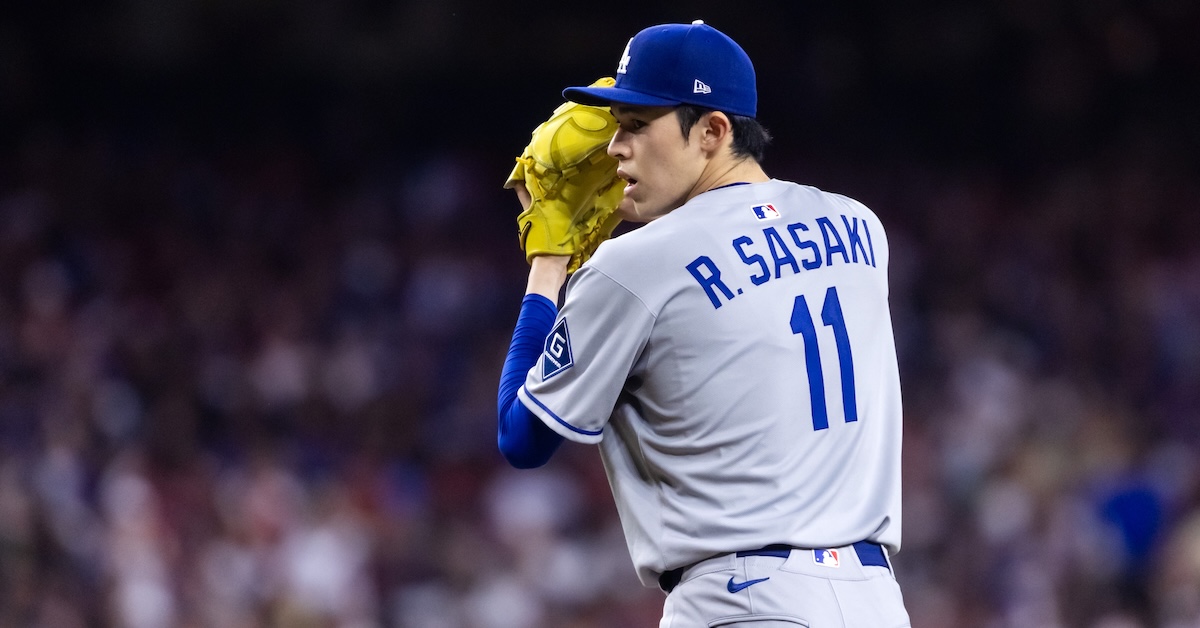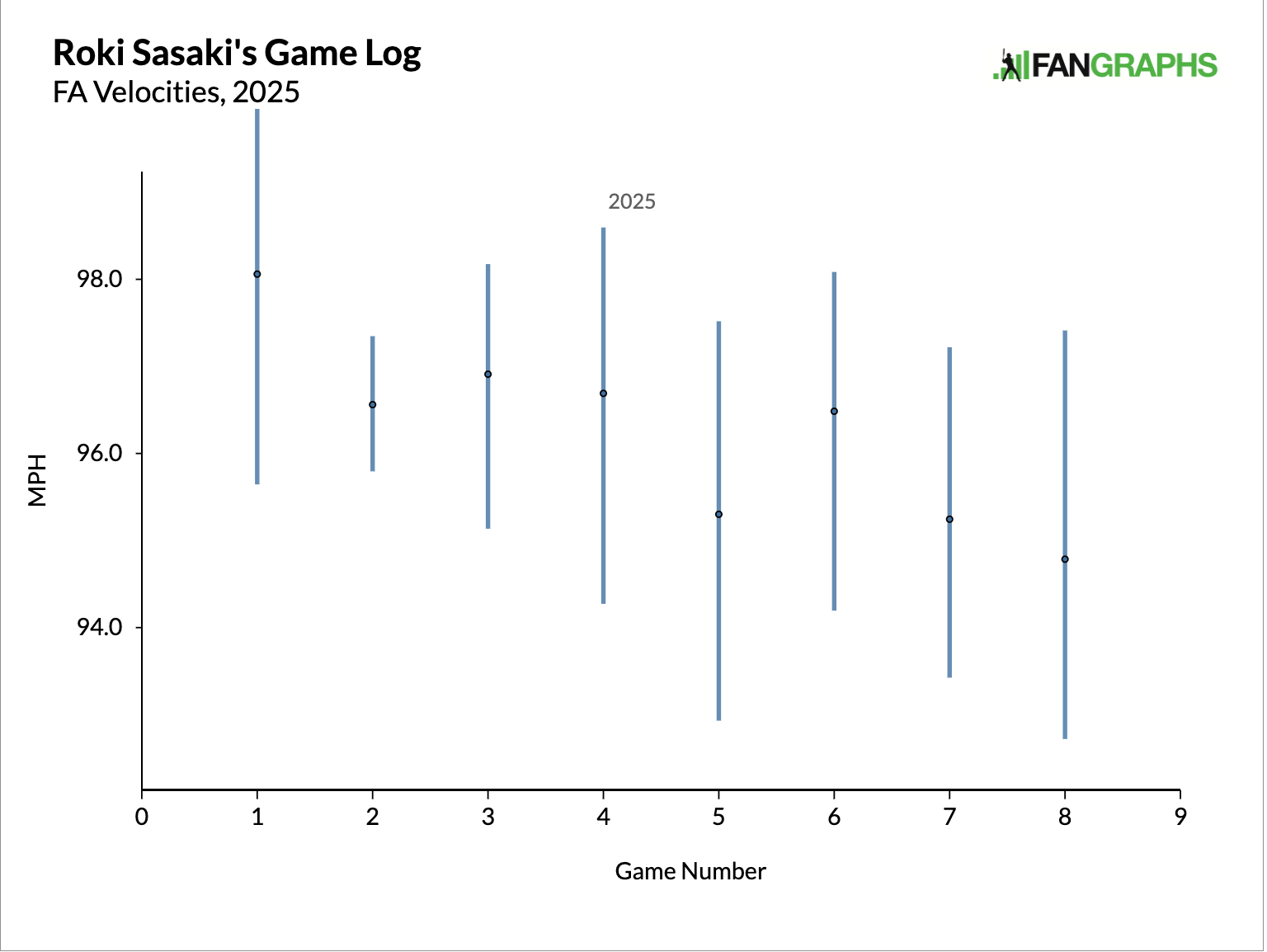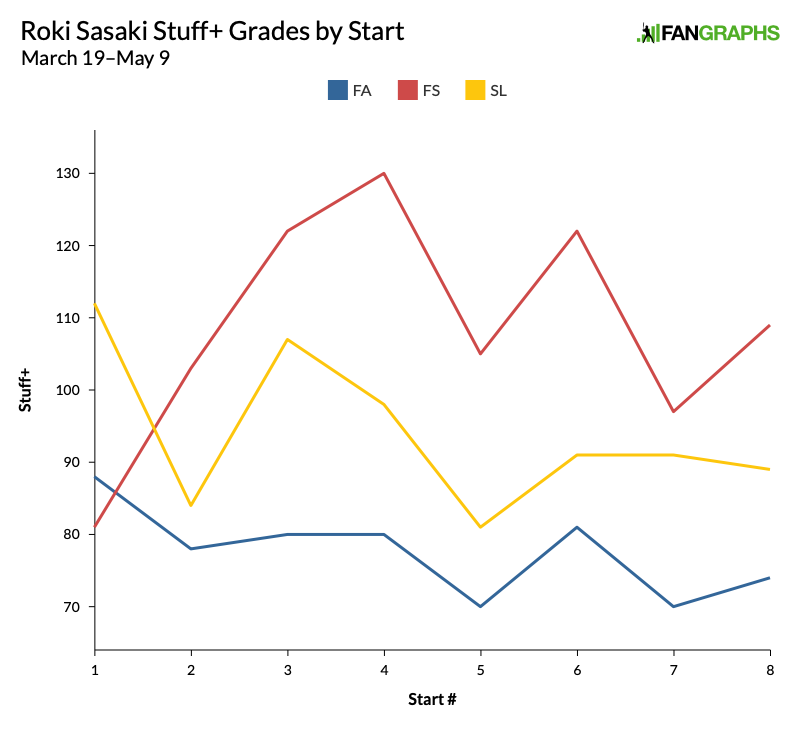Roki’s Rocky Rookie Season Takes a Rough Turn

Though Roki Sasaki’s deal with the Dodgers wasn’t anywhere close to the winter’s biggest, few free agents were so coveted or came with as much hype attached. Known as “The LeBron James of Japanese baseball” for his exploits in high school, he was dominant — even transcendent — during his 2021–24 NPB run with the Chiba Lotte Marines. As he went through the posting process, his combination of youth and a tantalizing repertoire featuring an elite, 80-grade splitter as well as a fastball with triple-digit velocity generated widespread interest by teams, though a dip in that velo last year did rate as a cause for concern. Now, eight starts into his career with the Dodgers, the 23-year-old righty has been underwhelming, and now he’s hurt, too. On Tuesday, the team placed him on the 15-day injured list due to a shoulder impingement, continuing the dizzying level of turnover within the rotation of the NL West leaders.
This is the latest turn in what’s been a rocky rookie season for Roki. Through 34.1 innings — about 4 1/3 per start — he’s carrying a 4.72 ERA, a 6.16 FIP, and a 6.13 xERA. He’s struck out just 15.6% of batters, while walking 14.3% (the highest mark of any pitcher with at least 30 innings), and has served up 1.57 homers per nine. His 21.9% chase rate is the third-lowest at that 30-inning cutoff.
Batters have struggled to do anything with Sasaki’s splitter, which he’s thrown in the zone just 29.6% of the time; they’ve chased it 30.4% of the time, and overall have hit .137 and slugged .237 against it. Even so, his 35% whiff rate on the pitch is well off the 56.5% whiff rate it generated last year in NPB according to Sports Info Solutions. Batters have fared better against his slider (.250 AVG/.417 SLG, 33.3% whiff) and his four-seamer (.253 VG/.494 SLG, 10.1% whiff), rarely chasing either (14% of the time for the former, 15% for the latter). All six of his home runs allowed have been off of four-seamers, as have two would-be homers robbed by Andy Pages; his xSLG on that pitch is a worrisome .663. His 17.8% whiff rate on four-seamers in the upper third of the strike zone or higher is better, but batters have still slugged .692 on pitches there, with a .903 xSLG.
The Dodgers have kept Sasaki on a short leash, allowing him to throw at least 90 pitches just twice, with a high of 98 on May 3 against the Braves, but part of the reason for his limited workload is that he’s rarely pitched well enough to merit working much deeper into games. That appeared to be the case last Friday, when he made the worst start of his brief big league tenure against the Diamondbacks at Chase Field. In four-plus innings, he threw just 61 pitches but allowed five runs and two homers, both season highs. For the first time this year, he didn’t strike out a single batter. His total of four swinging strikes was also a season low, and his 94.8 mph average four-seam fastball velocity was 1.2 mph below his season average.
Sasaki began the fifth inning by walking Ketel Marte after a seven-pitch battle, and was charged with the run after reliever Anthony Banda served up a game-tying grand slam to Lourdes Gurriel Jr. later in the inning. The Dodgers ultimately won the back-and-forth slugfest — which included seven homers and squandered leads of 8-3 (by the Dodgers) and 11-8 (by the Diamondbacks) — thanks to a six-run ninth inning that was capped by Shohei Ohtani’s three-run homer.
“We became aware of this after his last start in Arizona,” said manager Dave Roberts on Tuesday regarding Sasaki’s shoulder troubles. “From what we gather, he’s felt some discomfort for the last few weeks, but given where we’re at as a pitching staff, he wanted to continue to go and persevere and fight through everything until his performance was going to be compromised. So that’s when he let us know where he was at physically.”
Ugh. It’s an all-too-familiar story: A pitcher fighting through discomfort out of concern for the general state of his staff has only exacerbated both his condition and that of the team. Roberts added that Sasaki suffered similar shoulder soreness last year while being limited to 18 starts and 111 innings in Japan.
The Dodgers discovered the impingement after sending Sasaki for an MRI, and have shut him down indefinitely. “We made it very clear to Roki that there is no expectation on timeline,” said Roberts. “The main thing is that he’s healthy, he’s strong, his delivery feels good, then he’ll pitch for us.”
Knowing that Sasaki has been pitching at less than full health for some time helps to explain his unremarkable performance, particularly when it comes to his flagging velocity. Given that he averaged 98.3 mph with his four-seam fastball in 2022, and 98.9 in ’23 — and has been clocked as high as 103 — the baseball world has been waiting to see him summon elite heat. Yet he’s reached 100 mph just twice, and 99 just six times. In fact, his 13 fastest pitches, all 98.4 mph and above, were all thrown in his March 19 major league debut against the Cubs in Tokyo, when he walked five but allowed just one hit and one run over three innings. The Case of the Missing Velocity — he’s averaged just 95.7 mph with his four-seamer in his seven starts since his debut, and was below 95 in three of his last four turns — has since confounded the Dodgers.
Indeed, the Case of the Missing Velocity was said to be a critical element of teams’ pursuit of Sasaki, whose average four-seam velo dipped two ticks to 96.9 last year, according to SIS, and whose stuff was generally down when Eric Longenhagen checked in last August. As The Athletic summarized, “He asked each potential employer to explain the reason behind a vexing issue that lingered over his final season before a long-anticipated jump to the majors: Why did his velocity fall off?” The pitcher wanted each team he met with to present its analysis not only so he could gain insight into the issue but to understand their approach to conveying information — an assignment that rankled some teams. In the view of one decision-maker, he was “asking for some things that get beyond that line of proprietary.”
For Sasaki, the issue is that he needs that high-end velocity because his heater has below-average spin (just 2,080 rpm) and vertical break (14.3 inches of induced movement, 1.6 inches below average), so it’s flatter and straighter than most, lacking in deception. It’s easier to hit unless it’s really humming.
Compare that vertical break to what we saw in the 2023 World Baseball Classic. From The Athletic’s Eno Sarris last November:
Sasaki had 17-plus inches of induced vertical movement and 13 inches of horizontal movement in the WBC. At 98-plus mph, his fastball comps to those numbers are hard-throwing relievers like Kansas City Royals closer Lucas Erceg and New York Mets setup man Ryne Stanek, and maybe Hunter Greene among starters. At 96-plus, the comps are a little less exciting: Cleveland Guardians starter Gavin Williams and reliever Yimi García have some commonalities with their fastballs. And, according to Lance Brozdowski, Sasaki also lost a couple of inches of ride on the fastball in 2024 in Japan. It’s a really good fastball either way, but there are some indications it’s moving in the wrong direction.
“The velocity allows for that margin of error,” said pitching coach Mark Prior recently. “And clearly, that’s not there [right now].”
Sasaki’s command and location are issues as well. “I think guys are on his fastball because it’s the one thing that’s probably in the zone more than anything,” said Prior. “This goes back to his ability to throw the other pitches for strikes, and be able to mix, probably balance with all three.”
Even in the limited data Sasaki has produced — around 300 four-seamers thrown — the outlines of the trend are clear. Batters do much better against his fastball based on its velocity:
| Velo | % | PA | HR | Hor | Vert | AVG | xBA | SLG | xSLG | wOBA | xwOBA | Whiff% | Brl% | HH% |
|---|---|---|---|---|---|---|---|---|---|---|---|---|---|---|
| >97 | 23.2% | 18 | 1 | 11.1 | 14.4 | .133 | .267 | .333 | .461 | .281 | .378 | 16.2% | 7.7% | 46.2% |
| 95–97 | 55.0% | 57 | 1 | 10.6 | 14.2 | .267 | .265 | .333 | .455 | .355 | .388 | 9.4% | 7.7% | 51.3% |
| <95 | 21.9% | 24 | 4 | 9.8 | 14.6 | .261 | .388 | .826 | 1.137 | .465 | .631 | 5.9% | 30.4% | 60.9% |
I couldn’t fit everything I wanted to fit into that table, but given those numbers, it’s not surprising that the average launch angle decreases with the pitch speed, from 19 degrees for the slowest bucket to 12 for the middle and five for the fastest.
This is all a problem given his velocity trend:

The condition of Sasaki’s shoulder isn’t the only potential factor cutting into his velocity, as the team has discussed him dialing it back a bit in order to improve his command. According to Prior, “clearly some delivery things” are contributing as well.
Our two pitch modeling systems regard Sasaki’s splitter as excellent, but they have been largely unimpressed with his overall arsenal and particularly his four-seamer, with PitchBot grading it at 44 on the 20-80 scouting scale (50 is average) and Stuff+ grading it at 78 on a scale where 100 is average. The four-seamer at least has the best command/location grades of his three pitches:
| bot Stf FA | bot Cmd FA | botStf FS | bot Cmd FS | botStf SL | bot Cmd SL | botStf | botCmd | botOvr |
|---|---|---|---|---|---|---|---|---|
| 44 | 45 | 75 | 35 | 43 | 29 | 57 | 34 | 37 |
| Stf+ FA | Loc+ FA | Stf+ FS | Loc+ FS | Stf+ SL | Loc+ SL | Stuff+ | Location+ | Pitching+ |
| 78 | 99 | 110 | 85 | 90 | 84 | 91 | 92 | 85 |
It shouldn’t be a surprise that his stuff has generally been trending downwards:

Beyond the performance issues, Sasak’s injury comes at an inopportune time, because three-fifths of the Dodgers’ season-opening rotation is now on the shelf. Blake Snell made just two starts before being sidelined as of April 6 due to shoulder inflammation. The Dodgers initially hoped he would miss just two starts, but after throwing a bullpen session on April 19, his next session was scrapped because he felt discomfort while playing catch. He received an MRI at that point, as well as a cortisone injection. After further delays due to continued discomfort, and a visit to Dr. Neal ElAttrache, he was finally able to resume playing catch on Wednesday.
Tyler Glasnow, who left his fifth start of the season after one inning on April 27 due to shoulder discomfort, is the other member of the original five on the IL. He too was diagnosed with shoulder inflammation, but was able to resume playing catch on Sunday, and the hope is that he could return later this month. “Tyler started a throwing progression,” said Roberts on Tuesday. “He’ll continue to work toward a bullpen, and we’ll have a more clear picture later this homestand. But he has started throwing a baseball.”
The three injuries leave Yoshinobu Yamamoto and Dustin May the only members of the season-opening rotation who are still healthy. Yamamoto has been stellar, though after posting a 0.90 ERA through his first seven starts, a five-run, five-inning drubbing by the Diamondbacks doubled that to 1.80, and after Wednesday’s six-inning, three-run start against the A’s, he’s up to 2.12, though that’s still good for third in the NL. Though 51 innings, he’s fifth in the league in strikeout rate (29.6%) and eighth in FIP (3.06) as well. May, who missed most of 2023 and all of ’24 due to Tommy John surgery and then an esophageal tear, has posted a 4.08 ERA and 3.96 FIP through seven starts totaling 39.2 innings. While those numbers aren’t outstanding, he’s gone at least five innings in all seven starts, no small contribution for a team whose rotation ranks last in the majors in innings (198.1).
Indeed, as with their championship run last October, the Dodgers have recently resorted to bullpen games to fill the cracks in their rotation; Jack Dreyer has made two such starts and Ben Casparius one, all since April 23. Landon Knack has made four starts and has been tagged for a 6.61 ERA and 4.88 FIP, which is at least better than Bobby Miller, who was tagged for six runs in three innings in his lone start before being optioned back to Oklahoma City as quickly as he’d arrived.
Not all is doom and gloom, however. Tony Gonsolin, who missed all of last season due to Tommy John surgery and then opened this one on the IL due to a back injury, has pitched effectively in his first three starts, striking out 21 and walking just four in 16 innings while posting a 2.81 ERA. Clayton Kershaw, who made just seven starts totaling 30 innings last year, then underwent a pair of offseason surgeries to repair a torn meniscus in his left knee and a ruptured plantar plane in his left foot, will make his 2025 season debut on Saturday. He’s made five rehab starts at three different levels since April 16, throwing as many as 66 pitches. When he returns, he’ll resume his countdown to becoming just the fourth southpaw to reach 3,000 strikeouts, after Steve Carlton, Randy Johnson, and CC Sabathia.
Given the money they spend and the success they’ve had, nobody will have much sympathy for the Dodgers, particularly when it seems as though every pitcher of theirs is suddenly at higher risk for injury. Still, given the fanfare and promise of Sasaki, it’s a bummer to see him struggle. Here’s hoping his shoulder heals, and that at some point soon we get to see what the fuss was all about.
Brooklyn-based Jay Jaffe is a senior writer for FanGraphs, the author of The Cooperstown Casebook (Thomas Dunne Books, 2017) and the creator of the JAWS (Jaffe WAR Score) metric for Hall of Fame analysis. He founded the Futility Infielder website (2001), was a columnist for Baseball Prospectus (2005-2012) and a contributing writer for Sports Illustrated (2012-2018). He has been a recurring guest on MLB Network and a member of the BBWAA since 2011, and a Hall of Fame voter since 2021. Follow him on BlueSky @jayjaffe.bsky.social.
Jay, I apologize since I’m sure it’s not your area of responsibility, but when does the rolling 10 free article counter reset? I have been stuck in article prison for over 2 months now with no idea when I’ll be released. In a perfect world, I would just be a member and I really wish I could be and support you all properly, but my family budget just doesn’t allow it. I know, I know, everyone is hurting right now and no one wants to hear it, but it’s true. If you could please let me know how to get out of article prison, it would be much appreciated. Thank you for everything you do.